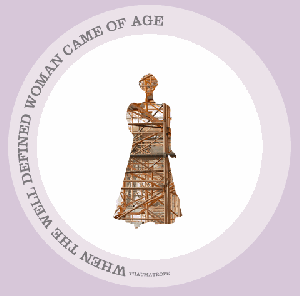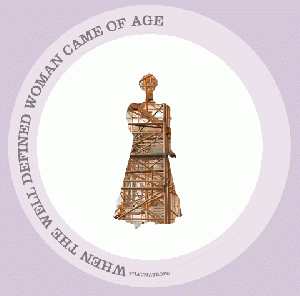Recently we invited a handful of artists to create digital works of art responding to the exhibitions on view in the new Resnick Pavilion. Bari Ziperstein, a graduate of CalArts who works in photography and sculpture, proposed a project inspired by Fashioning Fashion: European Dress in Detail, 1700–1915.
Bari says her work is inspired by "collage aesthetics and the lens of feminist domesticity, as well as America's love of excess and desire to collect." For this piece, she created a digital thaumatrope, below.

click to view the animation
The traditional thaumatrope, popular during Victorian times, consisted of a card with an image and a bit of text—a poem or riddle—on each side. Rotating the card resulted in the illusion of a single image in motion. Most nineteenth-century thaumatropes depicted a bird and cage, which, when rotated, made the bird appear to be in the cage. I asked Bari a few questions about the project.
How did you come up with this idea?
The thaumatrope is such a simple optical effect utilizing the persistence of vision. In this digital age, there is something so poignant about what can be done with a two-sided animation.
But there was a definite arc to my thinking about the project. At first I was just entranced by working with animated images, since I'm new to the medium. Then I asked myself, who cares? Where is the content? That’s probably my CalArts training speaking.
Why did you choose the format of the thaumatrope?
The content and the form line up perfectly. I was thinking about the arc of women’s liberation and the feminist history behind the time period covered by the exhibition, particularly the late 1800s and early 1900s. The thaumatrope as a binary construction tied directly to my thinking about the fact that some women were confined within their domestic life, while others had more choices. In the thaumatrope, the woman is caged, uncaged, caged, uncaged. It expresses two different ideas at the same time—perfect for a time when women’s roles were becoming more fluid, which effected an aesthetic shift in fashion in terms of the silhouette.
Where does the imagery in your piece come from?
The scaffolding is something I photographed at the Sagrada Familia in Barcelona. Gaudi was a visionary whose creation is still under construction. I like that as a metaphor too: as women, we are metaphorically under construction at all times.
I came to see and photograph the exhibition while it was being installed. The dresses were so inspiring. The first row of dresses in the exhibition as you enter say so much about what was happening culturally with women at the time. The curators are showing the evolution of the silhouette, the undergarments and how they were architectural structures on the body. That was fascinating to me, the connection between architecture and the way women’s roles are being constructed around this time in history.
I’ve been working with the idea of decorative protection for a while—my last show focused on the economy and security of domesticity in Los Angeles. I collect images of barred windows when I travel. So I brought in the idea of the door that you see in the piece—it comes from a found image from the 1980s showing how to protect your home. It’s timeless in a way.
I worked with my friend, writer Justin Lebanowski, on the text. Justin has titled many of my exhibitions and various projects. I found it really exciting to collaborate with him; we had long discussions and he was so important to this project. He gave me a list of twelve riddles to choose from.
What was it like working in this format?
It was a bit of a challenge. I haven’t made anything move before. I make sculpture and photography. But after visiting LACMA, I felt the thaumatrope was the perfect synthesis of the time period, the content and the medium I was asked to work within – something that could be distributed on the web and by cell phone.
Artists Respond is a series of ongoing digital commissions from artists interested in collaborating on creative projects that use the web and mobile technology to deliver art outside the museum’s walls.
You can also take part in another project by Bari Ziperstein, as part of Fallen Fruit’s Let Them Eat LACMA event on Sunday November 7. Bari is creating a piece called 1,095: One Year’s Worth of Other People’s Plates. She will create an interactive three-dimensional installation of other people’s ceramic plates in the shape of a mandala. Please donate a plate! For every plate you donate, you can pick out a new commemorative “1,095” plate during the event. More information.



